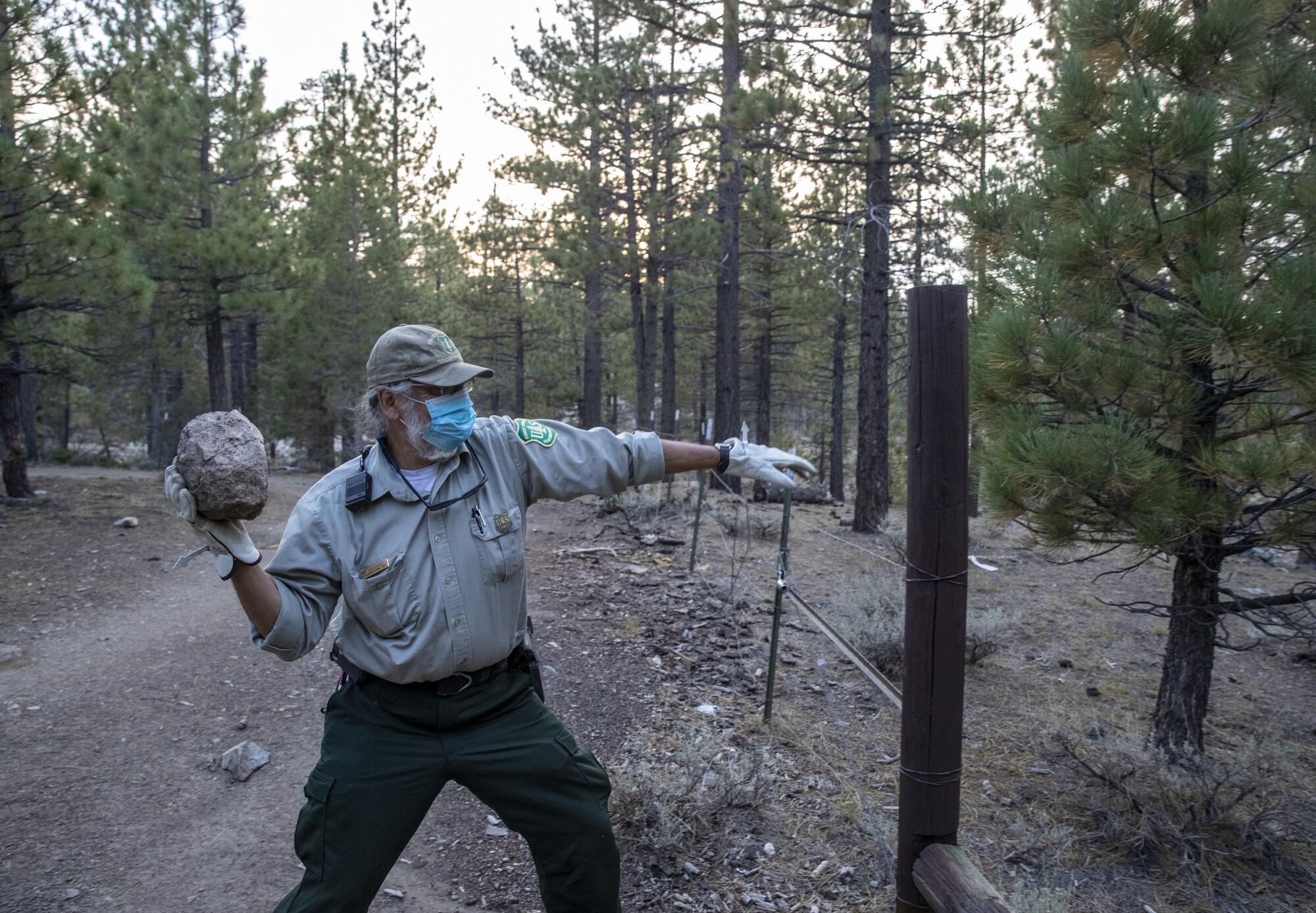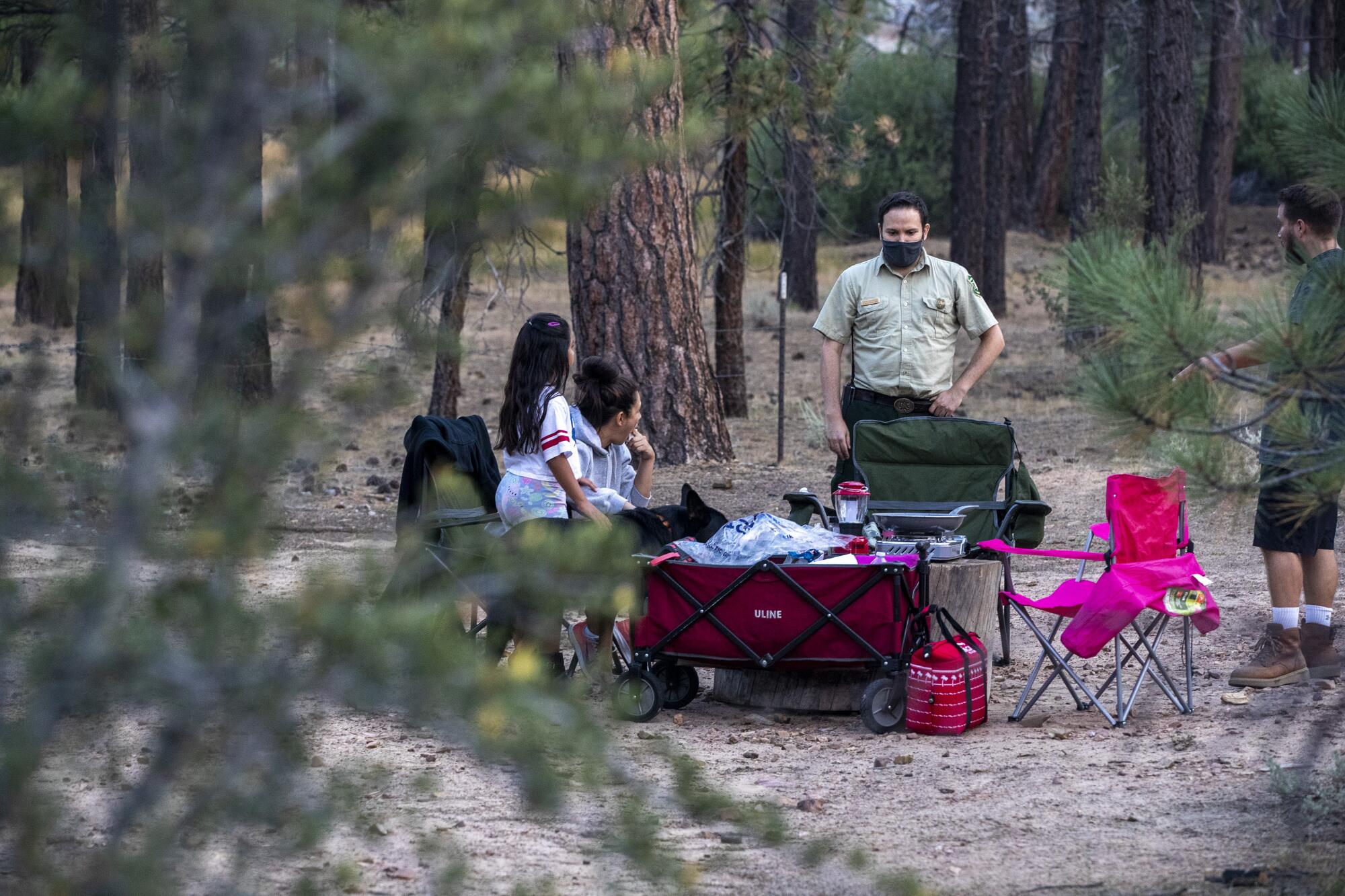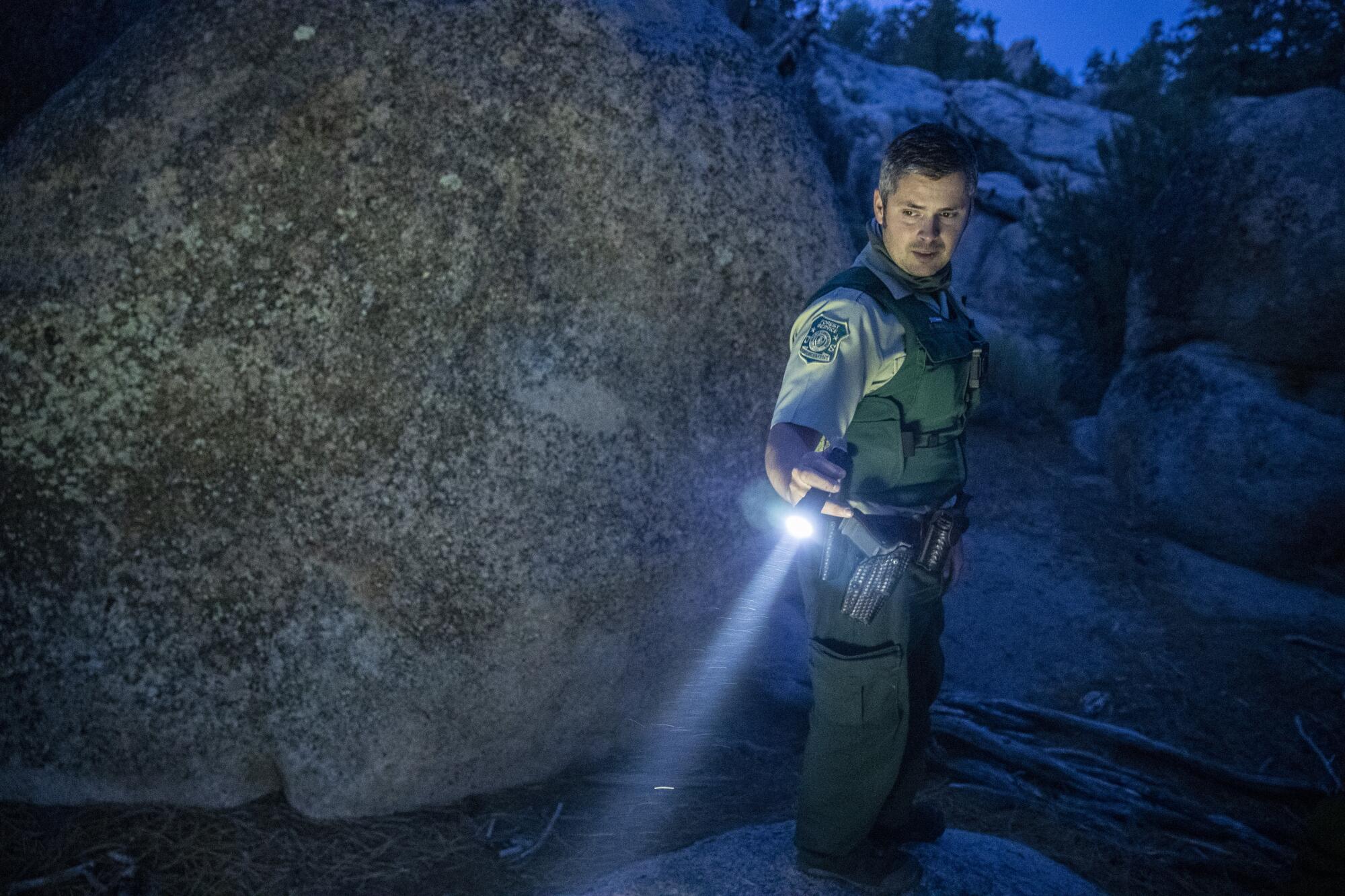
- Share via
Big Bear Lake, Calif. — As darkness fell on a campsite in a well-hidden glen in the San Bernardino Mountains recently, the soft clatter of a laptop keyboard on a portable picnic table was joined by the sound of footsteps trampling undergrowth as two U.S. Forest Rangers strode forward and said, in turn, “Howdy.”
The rangers methodically scanned the tiny, lonely patch of Holcomb Valley wilderness in which Jonathan Hong, 31, of Beverly Hills, was composing the opening chapters of his first science fiction novel. It didn’t take long for the rangers to find what they were looking for.
Nodding toward a nearby mound of charred wood encircled by softball-sized rocks, Ranger Chon Bribiescas asked, “Is that a campfire over there?”
“Yeah. It’s just a small one,” Hong, replied nervously, adding, “it’s not mine.”

Instantly and quietly, Bribiescas and Zachary Behrens set to work. With their bare hands, they gauged the heat of the campfire site – it was cold – then began picking up the rocks and tossing them into the forest.
“We can’t allow campfire rings like this to become reusable,” Behrens said, spreading dirt over the ashes with his boots.
Moments later, they were back in their pickups and trundling down a one-lane dirt road cutting through Holcomb Valley, about five miles north of Big Bear Lake, on a night patrol to eliminate illegal campfires.
As Southern Californians increasingly flock to the mountains for relief from a recent heat wave and months-long coronavirus restrictions, hundreds of illegal campfires have sprung up in dispersed campsites. Unlike developed campsites, which offer groomed campgrounds, toilet facilities and often fire rings or grills, dispersed campsites are simply forested areas where visitors pitch a tent.
So far this year, forest officials have documented a 270% increase in illegal campfires in the San Bernardino National Forest, the most densely populated and heavily used national forest in the United States. That’s a rise from 189 between January and August in 2019 to about 700 during the same period in 2020.
Under current fire restrictions, building a campfire is allowed only in fire rings provided by the Forest Service in some developed recreation sites. The same goes for wood or charcoal barbecues.
But the problem persists amid a fire season like no other. As the pine air filled with the snarling sounds of vehicles clawing for traction along the badly rutted dirt roads leading into Holcomb Valley, Northern California was under a state of emergency as firefighters battled more than 560 lightning-stoked wildfires across the state that have claimed the lives of at least seven people, destroyed hundreds of homes and scorched more than 1 million acres.
A small Cessna soared high above the Mojave Desert recently, its engine growling in the choppy morning air.
The tensions play out every day as thousands of vacationers stream into this popular resort community looking forward to an alpine escape of crisp mountain air, cool forest trails and cozy campfires.
Instead, they are greeted by a grim reality: By 1 p.m. on a recent Friday, all 13 campgrounds in the San Bernardino range were filled, and traffic along the main route into the community was clogged due to an onslaught of SUVs and four-wheel drive vehicles loaded with coolers, bicycles, fishing and climbing gear and barbecues.

“These visitors have two choices,” Behrens, 39, said. “They can turn around and head home, or search for a suitable place to camp for free in, say, Holcomb Valley.”
Many tourists think the effort is worth it. They have driven more than a hundred miles in their own vehicles to get to Big Bear Lake, a city of 6,000 year-round residents and summer crowds of more than 100,000 on Labor Day weekend. Today is their day.
But because of the increasing tourist pressure, “weekdays are now like weekends and weekends are like major holidays,” Behrens said. “And with the surge of visitors has come an uptick in illegal campfires all over the forest.”
Forest officials are embroiled in the issue across the state, as increasing numbers of summer travelers are avoiding planes and cruise ships and placing more value on forest recreation near their homes, blurring the distinctions between urban life and deep woods.

On a recent Friday in the San Bernardino forest, rangers discovered 11 illegal fire rings. In most cases, nearby campers insisted they had no idea who built them. In any case, Bribiescas left a written warning that said, “Friendly reminder: No campfires or charcoal bbq. Thank you.”
At sunrise the following morning, they smothered a few dozen more.
Then there was Andrew Dewlaney, 28, a middle school physical education teacher struggling with online teaching, and his wife Coree, 29, a nurse at the John F. Kennedy Memorial Hospital emergency room, who worried that their hard-won weekend getaway in Holcomb Valley was about to come to an abrupt end when the rangers walked up and said, in turn, “Hello there.”
It was 109 degrees in the shade with high humidity when they left their home in Indio, Calif., that morning, they said. The traffic congestion they encountered in Big Bear Lake that afternoon was a crushing disappointment. After several hours of searching unsuccessfully for an available space at a forest service campground, they ventured into Holcomb Valley.
The good news: They had a permit to use a propane-powered fire pit filled with lava rocks that they brought to provide a smoke-free semblance of a wood-fueled campfire. The bad news: the device was sitting on a thick bed of highly flammable pine needles.

But the rangers were sympathetic. Bribiescas used a rake to remove the needles from a patch of soil roughly five feet in diameter. “You should be good to go now,” he said.
Overall, the rangers encountered little resistance during their campfire patrol under a big sky filled with owls and a dazzle of stars. Whether they prevented a potentially catastrophic wildfire was anyone’s guess.
For Behrens, Bribiescas and Smith, it was all part of a day’s work in Southern California’s urban national forest.









